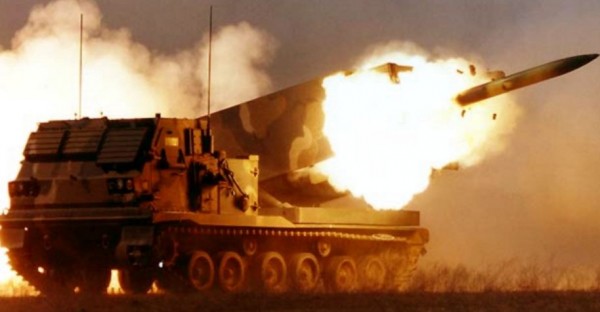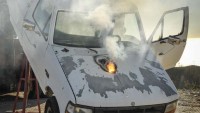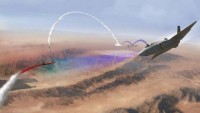Salvoes of New US Army GMLRS Rockets can Annihilate Seaborne Invaders
| Arthur Dominic Villasanta | | Sep 22, 2016 07:30 PM EDT |
(Photo : US Army) GMLRS being fired from a US Army MLRS.
The U.S. Army will soon begin receiving the first smart rockets for its "Guided Multiple Launch Rocket System" (GMLRS) that can hit targets out to 80 km and achieve the same destructive effect as cluster munitions now banned from the battlefield.
Like Us on Facebook
The precision and lethality of the GMLRS makes it suitable for defeating amphibious assaults on friendly coastlines or those of nations allied with the U.S. that intend to use this weapon. Launchers firing GMLRS can instantly saturate an invading force with the new high-velocity blast fragmentation "alternative warheads" as deadly as cluster munitions.
This new warhead is an area munition that achieves widespread battlefield destruction similar to that inflicted by cluster bomblets but without the potential dangers to civilians from bomblets that don't explode and remain on the battlefield. The new alternative warhead modifies existing technology to achieve the combat effect of cluster munitions but without dispersing bomblets.
GMLRS can destroy fixed targets such as enemy bunkers, troop locations, armored vehicles, equipment and other high-value targets.
The predecessor to the GMRLS, the M270 Multiple Launch Rocket System (MLRS) family of munitions, was rated by Iraqis that fought against U.S. forces in the Gulf War of 1990-91 as the weapon they most feared. Iraqis took to calling incoming MLRS rockets "steel rain."
GMLRS can be used on the legacy MLRS armored vehicle launcher or on the Army's newer M142 High Mobility Artillery Rocket System (HIMARS). This weapon is a light multiple rocket launcher mounted on a standard Army Medium Tactical Vehicle (MTV) truck frame.
HIMARS carries six MLRS rockets. It will also be able to transport and fire GMLRS rockets.
For its accuracy, GMLRS relies on GPS and Inertial Measurement Navigation technology to guide 90 kilogram unitary warheads toward their targets. The new unitary warhead (or a warhead with a single explosive charge) uses "height of burst" explosion technology to destroy an enemy target through what's called an "area effect."
GMLRS can also fire unitary warheads to destroy underground targets with a delayed fuse, or achieve a proximity or "area effect" similar to the alternative warhead.
Each GMLRS Alternative Warhead rocket will be packaged in an MLRS launch pod and will be fired from the Lockheed Martin HIMARS or the M270 family of launchers.
Cluster weapons are now banned by an international agreement called the Convention on Cluster Munitions.
TagsU.S. Army, Guided Multiple Launch Rocket System, GMLRS, M270 Multiple Launch Rocket System, M142 High Mobility Artillery Rocket System, HIMARS, Alternative Warhead
©2015 Chinatopix All rights reserved. Do not reproduce without permission
EDITOR'S PICKS
-

Did the Trump administration just announce plans for a trade war with ‘hostile’ China and Russia?
-

US Senate passes Taiwan travel bill slammed by China
-

As Yan Sihong’s family grieves, here are other Chinese students who went missing abroad. Some have never been found
-

Beijing blasts Western critics who ‘smear China’ with the term sharp power
-

China Envoy Seeks to Defuse Tensions With U.S. as a Trade War Brews
-

Singapore's Deputy PM Provides Bitcoin Vote of Confidence Amid China's Blanket Bans
-

China warns investors over risks in overseas virtual currency trading
-

Chinese government most trustworthy: survey
-

Kashima Antlers On Course For Back-To-Back Titles
MOST POPULAR
LATEST NEWS
Zhou Yongkang: China's Former Security Chief Sentenced to Life in Prison

China's former Chief of the Ministry of Public Security, Zhou Yongkang, has been given a life sentence after he was found guilty of abusing his office, bribery and deliberately ... Full Article
TRENDING STORY

China Pork Prices Expected to Stabilize As The Supplies Recover

Elephone P9000 Smartphone is now on Sale on Amazon India

There's a Big Chance Cliffhangers Won't Still Be Resolved When Grey's Anatomy Season 13 Returns

Supreme Court Ruled on Samsung vs Apple Dispute for Patent Infringement

Microsoft Surface Pro 5 Rumors and Release Date: What is the Latest?












